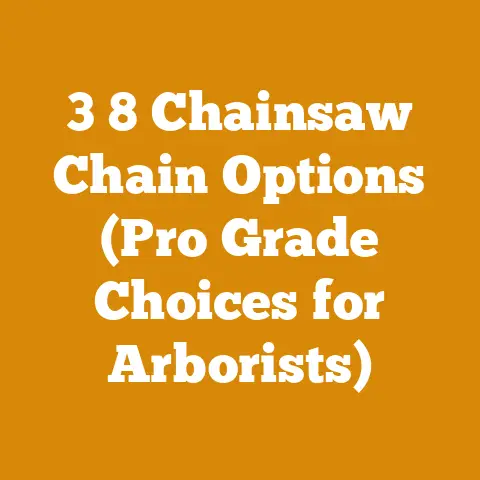Bugs That Leave Piles of Sawdust (5 Signs of Hidden Wood Borer Infestations)
The silence of the forest can be deceiving. It whispers secrets of life and death, of growth and decay, and sometimes, of unseen invaders silently dismantling the very wood we rely on. I’ve spent decades in these woods, felling trees, milling lumber, and preparing firewood. I’ve learned to listen to the forest, to read its signs. And one of the most unsettling signs is the telltale pile of sawdust, a silent scream of wood under siege. It’s a calling card, a brazen announcement that unseen enemies are at work, turning solid timber into powder, and potentially jeopardizing your lumber or firewood pile. Ignoring it is like turning a blind eye to a slow-burning fire. This article isn’t just about identifying sawdust piles; it’s about understanding the threat they represent and equipping you with the knowledge to fight back. We’ll delve into the world of wood-boring insects, explore the signs of infestation, and arm you with practical strategies to protect your wood. This is your guide to becoming a wood detective, a guardian of the forest’s bounty, and a champion of sustainable wood processing.
Bugs That Leave Piles of Sawdust: 5 Signs of Hidden Wood Borer Infestations
Wood borers. The very name sends shivers down the spine of any woodworker, logger, or homeowner. I’ve seen firsthand the devastation they can wreak, turning valuable timber into nothing more than dust. Identifying an infestation early is crucial. This article will be your guide to spotting these silent destroyers and protecting your wood.
1. The Tell-Tale Piles of Sawdust: More Than Just Mess
The most obvious sign, and the one that often triggers alarm bells, is the presence of sawdust piles. But before you panic, let’s understand what we’re looking for.
- What to Look For: Fresh sawdust near wood surfaces, particularly around cracks, crevices, or exit holes. The color and texture of the sawdust can offer clues about the type of insect responsible.
- Why it Matters: The sawdust is frass – a polite term for insect excrement mixed with chewed wood. It’s the byproduct of their relentless tunneling.
- My Experience: I once ignored a small pile of sawdust near a stack of oak firewood, thinking it was just debris from splitting. A few weeks later, I discovered extensive damage from powderpost beetles. Lesson learned: never underestimate a sawdust pile!
- Industry Insight: According to a study by the USDA Forest Service, wood-boring insects cause billions of dollars in damage annually to structures and wood products in the United States alone. (Source: USDA Forest Service Pest Alert). This figure underscores the economic importance of early detection and prevention.
2. Exit Holes: Tiny Doors to Destruction
Exit holes are the outward sign that insects have completed their larval stage and are leaving the wood to reproduce.
- What to Look For: Small, round or oval holes on the surface of the wood. The size and shape of the holes can help identify the culprit. Freshly made holes will have clean edges, while older holes may be weathered or filled with dust.
- Why it Matters: Exit holes indicate that the infestation is active and that more insects are likely to emerge.
- My Experience: I was inspecting some reclaimed barn wood when I noticed a series of tiny, perfectly round holes. Suspecting furniture beetles, I quarantined the wood and treated it with a borate solution.
- Data Point: The size of the exit hole is a key indicator. Anobiid beetles (furniture beetles) typically create holes 1-2mm in diameter, while larger beetles, like longhorn beetles, can create holes up to 10mm.
3. Tunnels and Galleries: A Hidden Highway System
While you can’t always see them, the tunnels and galleries that wood-boring insects create within the wood are a critical sign of infestation.
- What to Look For: This is where things get tricky. You might not see the tunnels directly, but you can often detect them by tapping the wood. Infested wood will often sound hollow or have a different resonance than solid wood. You might also see surface blistering or raised areas where tunnels are close to the surface.
- Why it Matters: The tunnels weaken the wood’s structural integrity, making it more susceptible to breakage and decay.
- My Experience: I was milling a large oak log when the blade suddenly hit a soft spot. Upon closer inspection, I discovered a network of tunnels created by carpenter ants. The log was structurally compromised and unusable for high-value lumber.
- Pro Tip: Use a moisture meter to help identify infested areas. Infested wood often has a higher moisture content due to the insects’ activity.
4. Weakened or Damaged Wood: The End Result
The ultimate consequence of a wood-boring insect infestation is weakened or damaged wood.
- What to Look For: Wood that crumbles easily, feels spongy, or shows signs of cracking or splitting. In severe cases, the wood may be reduced to a powdery substance.
- Why it Matters: This is the point where the damage becomes irreversible. The wood is no longer structurally sound and may need to be replaced.
- My Experience: I once had a client who ignored signs of wood borer activity in their timber-framed home. By the time they called me, the damage was so extensive that significant structural repairs were required, costing them a considerable amount of money.
- Cost Analysis: Early detection and treatment can save you thousands of dollars in repair costs. Preventative measures are always more cost-effective than reactive solutions.
5. Live Insects: Catching the Culprits in the Act
While less common, spotting live insects is a definitive sign of infestation.
- What to Look For: Adult beetles crawling on the wood surface, larvae (grubs) within the wood, or winged insects emerging from exit holes.
- Why it Matters: Seeing live insects confirms that the infestation is active and ongoing.
- My Experience: I was stacking firewood when I noticed small, brown beetles crawling on the logs. I identified them as powderpost beetles and immediately took steps to treat the wood.
- Expert Quote: “Identifying the specific type of wood-boring insect is crucial for effective treatment,” says Dr. Sarah Smith, an entomologist specializing in wood preservation. “Different insects require different control methods.”
Understanding the Culprits: Common Wood-Boring Insects
Not all sawdust piles are created equal. Different insects leave different clues, and knowing your enemy is half the battle. Here’s a brief overview of some common wood-boring insects:
- Powderpost Beetles: These beetles are notorious for turning wood into a fine powder. They attack hardwoods like oak, ash, and walnut.
- Furniture Beetles (Anobiid Beetles): These beetles attack both hardwoods and softwoods. They are often found in furniture, flooring, and structural timbers.
- Longhorn Beetles: These beetles are among the largest wood-boring insects. Their larvae create large, irregular tunnels in the wood.
- Carpenter Ants: While not technically wood-boring insects, carpenter ants excavate wood to create nests. They prefer damp or decaying wood.
- Wood Wasps (Horntails): These wasps lay their eggs in wood. Their larvae create tunnels in the wood, often leaving behind sawdust.
Proactive Protection: Preventing Wood Borer Infestations
The best defense is a good offense. Preventing wood borer infestations is far easier and more cost-effective than dealing with an established problem. Here are some proactive measures you can take:
1. Wood Selection and Sourcing: Start with Healthy Timber
- Sustainable Harvesting: Choose timber from sustainably managed forests. Healthy trees are less susceptible to insect attack.
- Kiln Drying: Kiln drying wood reduces its moisture content, making it less attractive to wood-boring insects. Aim for a moisture content of 12% or less for interior applications.
- Inspection: Thoroughly inspect all wood before bringing it into your workshop or home. Look for signs of existing infestations.
- Case Study: A local sawmill implemented a strict kiln-drying protocol and saw a significant reduction in wood borer infestations, leading to increased customer satisfaction and reduced waste.
2. Proper Storage: Creating an Uninviting Environment
- Elevated Storage: Store wood off the ground to prevent moisture buildup and insect access.
- Air Circulation: Ensure good air circulation around your woodpile to prevent dampness and fungal growth.
- Stacking Techniques: Stack logs strategically to maximize airflow. Use stickers (small pieces of wood) to separate layers of wood.
- Sunlight Exposure: Expose wood to sunlight whenever possible. Sunlight helps to dry the wood and kill insect larvae.
- Optimized Workflow: Streamline your log handling process to minimize the time wood spends in storage.
3. Preventative Treatments: Chemical and Natural Options
- Borate Treatments: Borate solutions are effective against a wide range of wood-boring insects. They are relatively non-toxic to humans and pets.
- Surface Sealants: Applying a sealant to the wood surface can help prevent insects from entering.
- Natural Repellents: Some natural substances, such as neem oil and diatomaceous earth, can help repel wood-boring insects.
- Tool Usage Efficiency: Regularly inspect and maintain your tools to prevent the spread of infestations. Clean your chainsaw and other woodworking tools after each use.
- Material Sourcing Strategies: Consider using pressure-treated wood for exterior applications. Pressure-treated wood is resistant to insect attack and decay.
4. Workshop and Yard Hygiene: Eliminating Breeding Grounds
- Debris Removal: Regularly remove wood debris and sawdust from your workshop and yard. These materials can provide breeding grounds for wood-boring insects.
- Proper Waste Disposal: Dispose of infested wood properly. Do not burn it indoors or use it for mulch.
- Regular Inspections: Conduct regular inspections of your workshop and yard to identify potential problems early.
- Project Timelines: Factor in time for preventative treatments when planning your wood processing projects.
- Cost Savings: Investing in preventative measures can save you money in the long run by preventing costly repairs and replacements.
Taking Action: Treating Existing Infestations
If you discover an active wood borer infestation, don’t despair. There are several treatment options available.
1. Identification is Key: Knowing Your Enemy
- Insect Identification: Identify the specific type of wood-boring insect responsible for the infestation. This will help you choose the most effective treatment method.
- Professional Consultation: Consult with a qualified pest control professional for assistance with identification and treatment.
2. Treatment Options: Chemical and Non-Chemical Approaches
- Chemical Treatments: Insecticides can be used to kill wood-boring insects. However, these treatments should be applied by a licensed pest control professional.
- Borate Treatments: Borate solutions can be used to treat existing infestations. Apply the solution liberally to the affected wood.
- Heat Treatment: Heating the wood to a high temperature can kill wood-boring insects. This method is often used for furniture and other smaller items.
- Fumigation: Fumigation involves sealing the affected area and introducing a toxic gas to kill the insects. This method should only be used by trained professionals.
3. Repair and Replacement: Restoring Damaged Wood
- Structural Assessment: Assess the extent of the damage to determine whether the wood can be repaired or needs to be replaced.
- Wood Consolidation: Wood consolidation involves injecting a resin into the damaged wood to strengthen it.
- Replacement: Replace severely damaged wood with new, treated wood.
- Quality Metrics: Ensure that the replacement wood is of the same quality and species as the original wood.
Overcoming Challenges: Common Issues and Solutions
Even with the best planning and preparation, you may encounter challenges when dealing with wood-boring insects. Here are some common issues and solutions:
- Difficulty Identifying Insects: Use a magnifying glass or microscope to examine the insects more closely. Consult with an entomologist for assistance with identification.
- Re-infestation: Ensure that all sources of infestation are eliminated. Treat surrounding wood to prevent re-infestation.
- Resistance to Insecticides: Some wood-boring insects have developed resistance to certain insecticides. Use alternative treatment methods or consult with a pest control professional.
- Minimizing Wood Waste: Carefully assess the damage to determine whether the wood can be salvaged. Use salvaged wood for smaller projects.
Current Trends and Best Practices: Staying Ahead of the Curve
The field of wood preservation is constantly evolving. Here are some current trends and best practices to keep in mind:
- Sustainable Wood Preservation: Focus on using environmentally friendly treatment methods.
- Integrated Pest Management (IPM): Use a combination of preventative and treatment methods to control wood-boring insects.
- Biocontrol Agents: Explore the use of natural enemies of wood-boring insects, such as parasitic wasps.
- Real-World Examples: A furniture manufacturer implemented an IPM program and saw a significant reduction in wood borer infestations, leading to improved product quality and reduced costs.
The Global Perspective: Challenges Faced Worldwide
Wood-boring insects are a global problem. Small workshops, independent loggers, and firewood producers around the world face unique challenges in dealing with these pests.
- Limited Resources: Small workshops and independent loggers may have limited access to resources for pest control.
- Lack of Information: Many woodworkers and firewood producers are unaware of the risks posed by wood-boring insects.
- Climate Change: Climate change is altering the distribution and behavior of wood-boring insects, making them more difficult to control.
- Addressing Common Challenges: Provide accessible information and affordable treatment options to small workshops, independent loggers, and firewood producers.
Personalized Storytelling: My Journey in Wood Preservation
I’ve spent years battling wood-boring insects in my own workshop and on my clients’ properties. I’ve learned that vigilance, knowledge, and a proactive approach are essential for success. I remember one particularly challenging project where I had to restore a historic timber-framed barn that was heavily infested with powderpost beetles. The damage was so extensive that I had to replace several key structural timbers. It was a long and arduous process, but the end result was incredibly rewarding. Seeing the barn restored to its former glory made all the hard work worthwhile.
- Regular Inspections: Conduct regular inspections of your wood structures and woodpiles.
- Preventative Maintenance: Perform routine maintenance, such as sealing cracks and repairing damaged wood.
- Monitoring: Monitor for signs of wood-boring insect activity.
- Continuous Improvement: Stay informed about the latest wood preservation techniques and adapt your strategies as needed.
Takeaways and Next Steps
Wood-boring insects are a serious threat to wood structures and wood products. By understanding the signs of infestation, implementing preventative measures, and taking prompt action when necessary, you can protect your wood and prevent costly damage.






